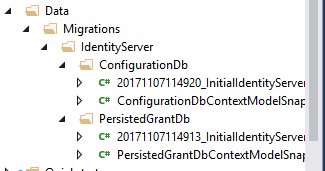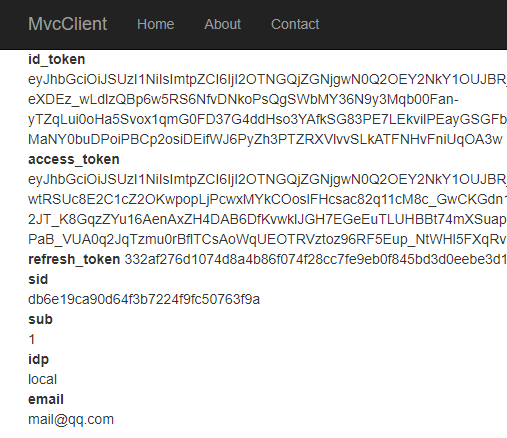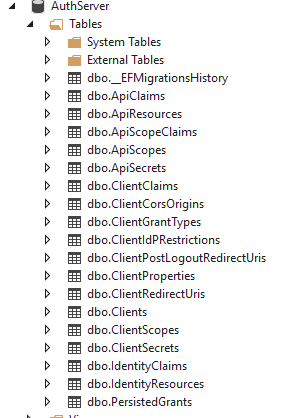使用Identity Server 4建立Authorization Server (5)
预备知识: http://www.cnblogs.com/cgzl/p/7746496.html
第一部分: http://www.cnblogs.com/cgzl/p/7780559.html
第二部分: http://www.cnblogs.com/cgzl/p/7788636.html
第三部分: http://www.cnblogs.com/cgzl/p/7793241.html
第四部分: http://www.cnblogs.com/cgzl/p/7795121.html
之前的配置都是在内存中, 下面将如何把这些数据存储到Sql Server数据库, 这样更适合生产环境.
这部分基本完全参考官方文档:
https://identityserver4.readthedocs.io/en/release/quickstarts/8_entity_framework.html
安装Entity Framework相关的库
为Authorization Server 添加 IdentityServer4.EntityFramework:

还需要安装Microsoft.EntityFrameworkCore.SqlServer:

最后是Microsoft.EntityFrameworkCore.Tools:

使用它可以进行迁移等操作.
然后使用命令行进入Auth Server项目的目录, 试一下dotnet ef命令:

很不幸, 没找到dotnet ef命令. 这里需要手动修改AuthServer的项目文件, 右键点击项目, 点击Edit AuthServer.csproj.
这部分操作的官方文档在这: https://docs.microsoft.com/en-us/ef/core/miscellaneous/cli/dotnet
我们需要添加这部分代码:
<ItemGroup>
<DotNetCliToolReference Include="Microsoft.EntityFrameworkCore.Tools.DotNet" Version="2.0.0" />
</ItemGroup>
然后回到命令行, 再执行 dotnet ef:

这次好用了. 接下来就是add migrations了.
幸运的是, 之前装的库里面有封装好的model, 它们可以自动创建migration文件.
这里一共有两个命令(migrations), 一个是为了IdentityServer的配置, 另一个是为了持久化授权.
dotnet ef migrations add InitialIdentityServerPersistedGrantDbMigration -c PersistedGrantDbContext -o Data/Migrations/IdentityServer/PersistedGrantDb
dotnet ef migrations add InitialIdentityServerConfigurationDbMigration -c ConfigurationDbContext -o Data/Migrations/IdentityServer/ConfigurationDb

运行发现了问题, 这是因为我们还没有配置AuthServer来使用数据库.
添加appSettings.json, 并指定连接字符串:
{
"ConnectionStrings": {
"DefaultConnection": "Server=(localdb)\\mssqllocaldb;Database=AuthServer;Trusted_Connection=True;MultipleActiveResultSets=true"
},
"Logging": {
"IncludeScopes": false,
"Debug": {
"LogLevel": {
"Default": "Warning"
}
},
"Console": {
"LogLevel": {
"Default": "Warning"
}
}
}
}
修改Startup.cs:
public class Startup
{
public Startup(IConfiguration configuration)
{
Configuration = configuration;
} public IConfiguration Configuration { get; } public void ConfigureServices(IServiceCollection services)
{
var connectionString = Configuration.GetConnectionString("DefaultConnection");
var migrationsAssembly = typeof(Startup).GetTypeInfo().Assembly.GetName().Name; services.AddIdentityServer()
// .AddDeveloperSigningCredential()
.AddSigningCredential(new X509Certificate2(@"D:\Projects\test\socialnetwork.pfx", "Bx@steel"))
.AddTestUsers(InMemoryConfiguration.Users().ToList())
.AddConfigurationStore(options =>
{
options.ConfigureDbContext = builder =>
builder.UseSqlServer(connectionString,
sql => sql.MigrationsAssembly(migrationsAssembly));
})
// this adds the operational data from DB (codes, tokens, consents)
.AddOperationalStore(options =>
{
options.ConfigureDbContext = builder =>
builder.UseSqlServer(connectionString,
sql => sql.MigrationsAssembly(migrationsAssembly)); // this enables automatic token cleanup. this is optional.
options.EnableTokenCleanup = true;
options.TokenCleanupInterval = 30;
}); services.AddMvc();
}
首先获取数据库连接字符串, 然后添加两部分配置, 一个是配置数据(clients, resources), 一个是操作数据(tokens, codes, consents同意).
再次运行命令行:
dotnet ef migrations add InitialIdentityServerPersistedGrantDbMigration -c PersistedGrantDbContext -o Data/Migrations/IdentityServer/PersistedGrantDb
dotnet ef migrations add InitialIdentityServerConfigurationDbMigration -c ConfigurationDbContext -o Data/Migrations/IdentityServer/ConfigurationDb

好用了.
看看生成的文件, 是有这两部分:

看一下文件的内容, 会发现有很多的Table.
下一步就是添加自动迁移, 暂且在StartUp里面找个位置新建个方法吧:
private void InitializeDatabase(IApplicationBuilder app)
{
using (var serviceScope = app.ApplicationServices.GetService<IServiceScopeFactory>().CreateScope())
{
serviceScope.ServiceProvider.GetRequiredService<PersistedGrantDbContext>().Database.Migrate(); var context = serviceScope.ServiceProvider.GetRequiredService<ConfigurationDbContext>();
context.Database.Migrate();
if (!context.Clients.Any())
{
foreach (var client in InMemoryConfiguration.Clients())
{
context.Clients.Add(client.ToEntity());
}
context.SaveChanges();
} if (!context.IdentityResources.Any())
{
foreach (var resource in InMemoryConfiguration.IdentityResources())
{
context.IdentityResources.Add(resource.ToEntity());
}
context.SaveChanges();
} if (!context.ApiResources.Any())
{
foreach (var resource in InMemoryConfiguration.ApiResources())
{
context.ApiResources.Add(resource.ToEntity());
}
context.SaveChanges();
}
}
}
首先是分别对两个context进行迁移, 然后判断是否这些表里是空的, 如果没有数据, 就把配置的内存数据添加到数据库里面.
别忘了在Configure方法调用:
public void Configure(IApplicationBuilder app, IHostingEnvironment env)
{
InitializeDatabase(app); app.UseDeveloperExceptionPage();
app.UseIdentityServer();
app.UseStaticFiles();
app.UseMvcWithDefaultRoute();
}
运行项目, 重新操作一下登陆, 同意的过程, 依然好用.

看一下数据库:

确实生成了很多表.
查看Clients表, 里面有三条数据.
PersistedGrants里面也有一条数据. 登陆时当你同意请求许可的时候, 就会在这个表里面添加一条数据.
把用户存储到数据库
可以使用自定义的用户表来存储用户数据, 但是我要用的是asp.net core identity, 所以我就不讲别的方式了.
不过首先, 需要重建个项目, 并且把之前讲的所有内容都操作一遍, 因为这里要使用asp.net core mvc 模板并使用Individual User Account的验证方式:

建立好项目后, 需要把之前讲的所有步骤操作一下, 然后安装: IdentityServer4.AspNetIdentity:

修改Startup, 大约成为这个样子, 只看红色部分即可:
namespace AuthorizationServer
{
public class Startup
{
public Startup(IConfiguration configuration)
{
Configuration = configuration;
} public IConfiguration Configuration { get; } public void ConfigureServices(IServiceCollection services)
{
var connectionString = Configuration.GetConnectionString("DefaultConnection");
var migrationsAssembly = typeof(Startup).GetTypeInfo().Assembly.GetName().Name; services.AddDbContext<ApplicationDbContext>(options =>
options.UseSqlServer(connectionString)); services.AddIdentity<ApplicationUser, IdentityRole>(options =>
{
// Password settings
options.Password.RequireDigit = false;
options.Password.RequiredLength = ;
options.Password.RequireNonAlphanumeric = false;
options.Password.RequireUppercase = false;
options.Password.RequireLowercase = false;
options.Password.RequiredUniqueChars = ;
// Lockout settings
options.Lockout.DefaultLockoutTimeSpan = TimeSpan.FromMinutes();
options.Lockout.MaxFailedAccessAttempts = ;
options.Lockout.AllowedForNewUsers = true;
// Signin settings
options.SignIn.RequireConfirmedEmail = false;
options.SignIn.RequireConfirmedPhoneNumber = false;
// User settings
options.User.RequireUniqueEmail = false;
})
.AddEntityFrameworkStores<ApplicationDbContext>()
.AddDefaultTokenProviders(); services.AddTransient<IEmailSender, EmailSender>();
services.AddMvc(); services.AddIdentityServer()
.AddDeveloperSigningCredential()
// .AddSigningCredential(new X509Certificate2(@"D:\Projects\test\socialnetwork.pfx", "password"))
.AddConfigurationStore(options =>
{
options.ConfigureDbContext = builder =>
builder.UseSqlServer(connectionString,
sql => sql.MigrationsAssembly(migrationsAssembly));
})
.AddOperationalStore(options =>
{
options.ConfigureDbContext = builder =>
builder.UseSqlServer(connectionString,
sql => sql.MigrationsAssembly(migrationsAssembly));
options.EnableTokenCleanup = true;
options.TokenCleanupInterval = ;
})
.AddAspNetIdentity<ApplicationUser>();
} public void Configure(IApplicationBuilder app, IHostingEnvironment env)
{
app.InitializeDatabase();
if (env.IsDevelopment())
{
app.UseDeveloperExceptionPage();
app.UseBrowserLink();
app.UseDatabaseErrorPage();
}
else
{
app.UseExceptionHandler("/Home/Error");
} app.UseStaticFiles();
app.UseIdentityServer();
app.UseMvc(routes =>
{
routes.MapRoute(
name: "default",
template: "{controller=Home}/{action=Index}/{id?}");
});
}
}
}
注意在Configure方法里面不要使用app.UseAuthentication(), 因为app.UseIdentityServer()方法已经包含了这个中间件. 然后使用命令行执行:
dotnet ef database update
或者在Packge Manager Console执行 update-database也行.
我照着官方文档操作出现了一些问题, 有几个重复的controller, 因为项目建立好之后有个HomeController和AccountController, 而使用Quickstart UI里面也有这两个Controller.
所以我最后clone了官方的例子: https://github.com/IdentityServer/IdentityServer4.Samples/tree/dev/Quickstarts/6_AspNetIdentity
修改了一下, 放到了我这个项目里: https://github.com/solenovex/Learning-Identity-Server-4
其他
有的项目可能需要使用第三方登陆, 例如使用Google账户, 微软账户, QQ等, 这部分请看官方文档自行学习吧. 我要做的是企业内部项目. 所以这块先不研究了.
也有可能会使用Auth0, Stormpath这样的OAuth Provider, Auth0我用过, 登陆有点慢, 但功能很强大. 这个也不讲了, 他们的文档写的很好, 也给出了各种客户端的代码, 很容易集成.
Javascript 客户端
这将是最后一部分.
手头的项目有点急. 过几天再写这个.
使用Identity Server 4建立Authorization Server (5)的更多相关文章
- 从头编写asp.net core 2.0 web api 基础框架 (5) + 使用Identity Server 4建立Authorization Server (7) 可运行前后台源码
前台使用angular 5, 后台是asp.net core 2.0 web api + identity server 4. 从头编写asp.net core 2.0 web api 基础框架: 第 ...
- 使用Identity Server 4建立Authorization Server
使用Identity Server 4建立Authorization Server (6) - js(angular5) 客户端 摘要: 预备知识: http://www.cnblogs.com/cg ...
- 使用Identity Server 4建立Authorization Server (1)
预备知识: http://www.cnblogs.com/cgzl/p/7746496.html 本文内容基本完全来自于Identity Server 4官方文档: https://identitys ...
- 使用Identity Server 4建立Authorization Server (4)
预备知识: http://www.cnblogs.com/cgzl/p/7746496.html 第一部分: http://www.cnblogs.com/cgzl/p/7780559.html 第二 ...
- 使用Identity Server 4建立Authorization Server (2)
第一部分: http://www.cnblogs.com/cgzl/p/7780559.html 第一部分主要是建立了一个简单的Identity Server. 接下来继续: 建立Web Api项目 ...
- 使用Identity Server 4建立Authorization Server (3)
预备知识: http://www.cnblogs.com/cgzl/p/7746496.html 第一部分: http://www.cnblogs.com/cgzl/p/7780559.html 第二 ...
- 使用Identity Server 4建立Authorization Server (6) - js(angular5) 客户端
预备知识: http://www.cnblogs.com/cgzl/p/7746496.html 第一部分: http://www.cnblogs.com/cgzl/p/7780559.html 第二 ...
- ASP.NET Core3.1使用Identity Server4建立Authorization Server
前言 网上关于Identity Server4的资料有挺多的,之前是一直看杨旭老师的,最近项目中有使用到,在使用.NET Core3.1的时候有一些不同.所以在此记录一下. 预备知识: https:/ ...
- 三、IDS4建立authorization server
建立authorization server 一.环境搭建 1.创建项目 2.引用NuGet的identityserver4 3.配置asp.net core 管道 打开Startup.cs, 编辑C ...
随机推荐
- [mysql]ERROR 1364 (HY000): Field 'ssl_cipher' doesn't have a default value 解决方法
在MySQL数据库中的mysql.user表中使用insert语句添加新用户时,可能会出现以下错误: ERROR 1364 (HY000): Field 'ssl_cipher' doesn't ha ...
- ubuntu远程桌面介绍
一.windows远程ubuntu14.04 由于xrdp.gnome和unity之间的兼容性问题,在Ubuntu 14.04版本中仍然无法使用xrdp登陆gnome或unity的远程桌面,现象是登录 ...
- java web 项目 图书管理系统的设计与实现
java web 项目 图书管理系统的设计与实现
- WPF自定义命令和处发命令
接实现ICommand接口的命令.在介绍之前,先看一下ICommand接口的原型: event EventHandler CanExecuteChanged; bool CanExecute(obje ...
- JavaScript设计模式--简单工厂模式例子---XHR工厂
第一步,Ajax操作接口(目的是起一个接口检测作用) (1)引入接口文件 //定义一个静态方法来实现接口与实现类的直接检验 //静态方法不要写出Interface.prototype ,因为这是写到接 ...
- 苹果 AR 新专利马上登陆 Facetime|Facebook 要用 VR 玩直播
附上VR技术福利视频 链接: https://pan.baidu.com/s/1boGGVs7 密码: viy8 点击关注有更多VR技术资源哦 苹果 AR 新专利马上登陆 Facetime ,使用光场 ...
- Spring MVC 过滤静态资源访问
过滤的必要性 一般来说,HTTP 请求都会被映射到 DispatcherServlet,进而由具体的类来承接处理,但对于类似 js 或者 css 这样的静态资源则没必要这样,因为对资源的获取只需返回资 ...
- 【JDK1.8】Java 8源码阅读汇总
一.前言 万丈高楼平地起,相信要想学好java,仅仅掌握基础的语法是远远不够的,从今天起,笔者将和园友们一起阅读jdk1.8的源码,并将阅读重点放在常见的诸如collection集合以及concu ...
- Delphi实现电脑端微信图片文件解密
电脑端微信收到图片后是存在了“C:\Users\系统用户名\Documents\WeChat Files\微信帐号\Data”目录下的,但文件不能直接使用图片浏览器打开的,因为做了一些加密,之前有个朋 ...
- eval函数的用法
可以把list,tuple,dict和string相互转化. ################################################# 字符串转换成列表 >>&g ...
